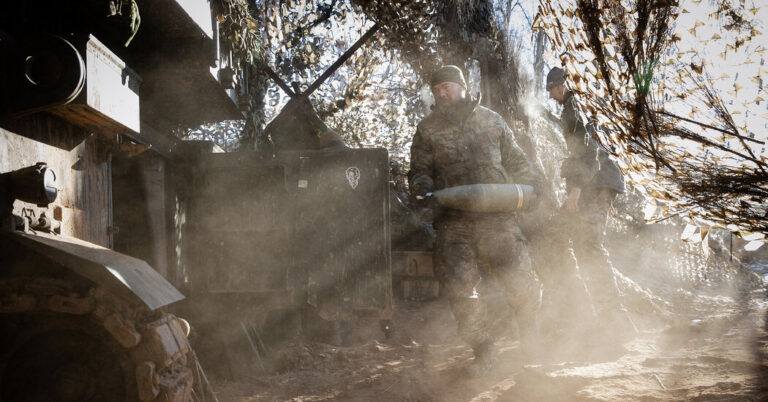Calls are growing among Western countries to allow attacks on Russian territory using weapons they have sent to the Ukrainian military, a move that Ukraine says will allow it to better prevent Russian attacks.
On Monday, NATO’s Parliamentary Assembly, made up of lawmakers from countries belonging to the military alliance, adopted a statement urging NATO members to lift the ban on firing Western weapons at Russia. This follows similar calls from NATO’s top official, Jens Stoltenberg, and ministers from the governments of Poland, Lithuania, Latvia and Sweden.
Calls to allow Ukraine to expand its use of Western weapons are aimed primarily at the United States, the Ukrainian government’s largest arms supplier. Washington has repeatedly asked Ukraine not to fire American-made weapons into Russian territory, for fear of an escalation of the war. has now opened within the Biden administration on the easing of the ban.
Ukraine has complained in recent months that the ban allows Russian forces to launch attacks from inside Russian territory safely and hampers its ability to repel them. That disadvantage became evident this month when Russia launched a new offensive in northeastern Ukraine after amassing troops and equipment just across the border.
“We had information from our intelligence services that Russia was accumulating troops across the border, but we could not strike them to prevent this offensive,” said Yehor Cherniev, vice president of the national security committee of the Ukrainian Parliament, in a telephone conversation. interview. “We had to wait for them to cross the border. » He added: “It cost us a lot of lives. »
Ukrainian officials now fear a similar scenario could happen again. Russia, they say, has amassed some 10,000 troops further north, across the border with Ukraine’s Sumy region, in preparation for a possible land offensive.
“Why can’t we use weapons to destroy them where they gather? » President Volodymyr Zelensky asked in a interview with the New York Times last week. “It would also help because they wouldn’t be united in one operation. They would know that if they pile up at any point, we will strike. »
For now, the Ukrainian army has limited itself to using Western weapons to strike targets located in Russian-occupied Ukrainian territory. Russian officials said Tuesday that the Russian-held city of Luhansk in eastern Ukraine was attacked twice overnight, with explosions rocking the city and fires.
Artem Lysohor, head of Ukraine’s military administration for the Luhansk region, said Ukraine was behind the attack. He made the statement in a social media post which included a video showing a large orange flame raging across the horizon at night, indicating that the attack was targeting an aircraft repair factory.
His claims could not be independently verified and it was unclear what type of weapon it was. But Luhansk lies more than 80 kilometers behind Russian lines, a distance that Ukraine could reach with its arsenal of medium- and long-range Western missiles. Military experts And Think tanks said Ukraine struck a Russian military training ground near Luhansk this month, likely with long-range ATACMS missiles supplied by the United States.
Ukrainian officials say such strikes in Russia would allow them to degrade Moscow’s ability to stage military operations. kyiv has used its fleet of long-range homemade drones to target airfields and energy infrastructure in Russia, but it does not produce the type of powerful missiles or long-range artillery that could bombard major military complexes.
Latvian President Edgars Rinkevics told CNN Monday that Russia’s recent advances in the northeast were “the consequence of our inability to supply weapons to Ukraine” and restrictions on the use of “these weapons to strike military targets in Russia.”
Latvia is one of several countries in Europe that have recently asked Ukraine to use Western weapons against Russian territory. Going further, Britain and Sweden, which joined NATO just two months ago, have suggested that Ukraine could use its weapons to strike inside Russia. Britain sent powerful long-range Storm Shadow missiles to kyiv, and Sweden supplied several self-propelled artillery systems.
The Kremlin has warned that the use of Western weapons on Russian soil would lead to an escalation of the war and provoke retaliation. On Tuesday, Dmitri Peskov, Kremlin spokesperson, told Izvestiaa Russian newspaper calling for allowing Ukraine to fire weapons on Russia was “absolutely irresponsible and provocative.”
Some lawmakers in the United States and France have also written to their governments in recent days asking them to lift the ban on the use of Western weapons.
The two countries are now consider sending military personnel to Ukraine to help train Ukrainian troopswhich raises questions about how they would react if Western coaches were attacked by the Russians.
Monday, General Oleksandr Syrskycommander-in-chief of Ukraine, welcomed in a message on social networks “France’s initiative to send instructors to Ukraine to train Ukrainian military personnel”, saying that he had already signed documents that would facilitate their arrival. Ukrainian Ministry of Defense later clarified that no decision had been made and that the Ukrainian and French governments were “still in discussions” on the issue.
Faced with Russia’s advance on the Ukrainian battlefield, several countries have increased their military support for Ukraine in recent months. Mr. Zelensky traveled to Spain on Monday and then to Belgium on Tuesday to sign bilateral agreements. security Agreements.
These agreements are part of a series of such commitments to Ukraine made over the past year by more than 30 countries. They aim to provide Kiev with sufficient security assistance to deter further Russian aggression, including by delivering key weapons, training troops and sharing intelligence.
As part of the agreements, Spain and Belgium said they would provide one billion euros, or about $1.1 billion, in military aid to Ukraine this year. Belgium has also committed to supplying kyiv with 30 F-16 fighter jets over the next four years.


